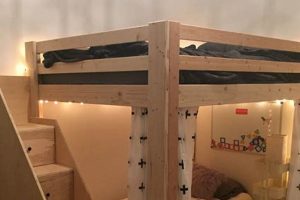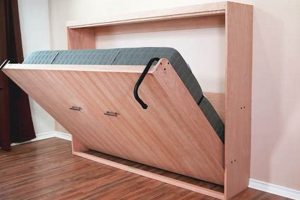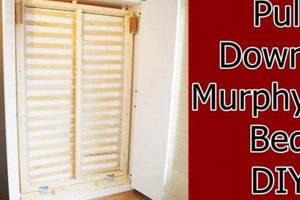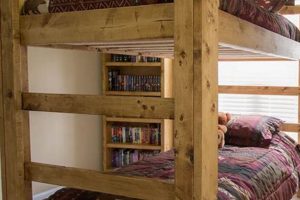A do-it-yourself elevated garden structure, often constructed from readily available materials, providing a controlled environment for plant cultivation. This structure typically features a frame that supports a transparent or translucent covering, shielding plants from harsh weather and extending the growing season. For example, a gardener might use lumber to build a frame on top of a raised bed and then cover it with plastic sheeting to create this type of structure.
The advantages of such a structure include improved temperature regulation, protection from pests and diseases, and the ability to start plants earlier in the season. Historically, the concept of protected cultivation dates back to ancient times, with variations evolving over centuries. The modern iteration combines the benefits of raised bed gardening with greenhouse technology, offering a practical solution for urban gardeners and those seeking increased yields or longer growing seasons.
The following sections will detail the essential considerations for building such a structure, encompassing design choices, material selection, and construction techniques. Furthermore, it will explore strategies for optimizing the internal environment to maximize plant health and productivity.
Essential Considerations for Construction
Careful planning and execution are paramount when constructing a growing structure of this nature. The following tips outline critical factors to ensure structural integrity and optimal plant growth.
Tip 1: Foundation Stability: Ensure a level and stable base for the raised bed. Uneven ground can compromise structural integrity and lead to instability. Consider using gravel or compacted soil to create a firm foundation.
Tip 2: Material Selection for Frame: Opt for durable, weather-resistant materials for the frame. Treated lumber, cedar, or metal are viable options. Untreated lumber will degrade more quickly, requiring more frequent replacement.
Tip 3: Glazing Material Durability: Select glazing materials that offer both light transmission and durability. Polycarbonate panels are more impact-resistant than glass or polyethylene sheeting and provide better insulation.
Tip 4: Ventilation System Implementation: Incorporate adequate ventilation to regulate temperature and humidity. Hinged windows or vents near the top of the structure are essential to prevent overheating and fungal diseases.
Tip 5: Secure Fastening Techniques: Use appropriate fasteners to secure the frame and glazing. Screws offer greater holding power than nails, especially in exposed environments. Ensure fasteners are rust-resistant.
Tip 6: Consider Height and Accessibility: Design the structure with sufficient height to accommodate plant growth and ease of access. A height of at least four feet is generally recommended.
Tip 7: Soil Drainage Management: Ensure adequate drainage within the raised bed to prevent waterlogging. Incorporate drainage layers of gravel or coarse sand at the bottom of the bed.
Employing these construction techniques maximizes the longevity and effectiveness of the structure, leading to healthier plant growth and greater yields.
In conclusion, the construction phase significantly impacts the overall success of this gardening method. The next section will address environmental control and maintenance.
1. Design Considerations
Design Considerations are fundamental to the efficacy of any structure. In the context of an elevated garden structure, thoughtful planning directly influences the system’s environmental control, resource utilization, and overall plant health. For instance, the orientation of the structure relative to the sun’s path is a critical design decision. A south-facing orientation in the Northern Hemisphere maximizes solar gain during the winter months, extending the growing season. Conversely, inadequate attention to this detail can result in insufficient sunlight exposure, hindering plant development and productivity. The dimensions of the structure must also be considered, balancing available space with the need for adequate headroom and planting area.
The choice of materials and construction methods significantly affects both the structure’s longevity and its ability to maintain a stable internal environment. Selection should account for local climate conditions, ensuring the frame can withstand wind loads, snow accumulation, and potential pest infestations. For example, using pressure-treated lumber for the frame can prevent rot and decay, while a robust glazing material, such as polycarbonate, offers both impact resistance and insulation. Furthermore, the design must incorporate adequate ventilation to regulate temperature and humidity. Passive ventilation systems, such as roof vents or adjustable side panels, can effectively dissipate excess heat during warmer months. Failure to properly integrate ventilation can lead to overheating, which stresses plants and increases the risk of disease.
Ultimately, the integration of meticulous design considerations into the planning phase translates into a resilient and productive cultivation environment. Addressing potential challenges related to sunlight exposure, structural integrity, and environmental control enhances the functionality and minimizes long-term maintenance requirements. The initial design phase is an investment that yields significant returns in terms of plant health, yield, and the overall sustainability of the gardening practice.
2. Material Selection
Material selection exerts a direct influence on the performance, longevity, and environmental impact of a do-it-yourself elevated garden structure. The choice of materials for the frame, glazing, and bed construction dictates the structure’s ability to withstand environmental stresses, retain heat, and provide a suitable growing environment. For example, using untreated wood for the frame, while initially cost-effective, leads to premature decay due to moisture exposure, necessitating frequent repairs or replacement. Conversely, pressure-treated lumber or naturally rot-resistant woods such as cedar offer increased durability and longevity.
Glazing material selection directly affects light transmission, insulation, and impact resistance. Polyethylene film, while inexpensive, degrades under ultraviolet exposure and provides minimal insulation. Polycarbonate panels, though more expensive, offer superior light transmission, insulation, and impact resistance, leading to better temperature control and plant protection. Similarly, the material used for the raised bed construction impacts soil drainage, nutrient retention, and structural integrity. Metal beds can leach elements into the soil, while untreated wood can introduce contaminants. Therefore, careful consideration of each material’s properties is crucial for optimizing growing conditions and minimizing environmental risks. A practical understanding of material properties allows for informed decisions that enhance the structure’s performance and sustainability.
In summation, material selection represents a fundamental aspect of constructing a do-it-yourself elevated garden structure. The interplay between material properties, environmental factors, and intended use dictates the structure’s overall success. While challenges exist in balancing cost, durability, and environmental impact, a thorough understanding of material science enables the creation of efficient and sustainable growing environments. Strategic planning regarding this ensures both the functionality and the long-term viability of the gardening initiative.
3. Ventilation Strategy
Ventilation strategy is an integral design consideration for any enclosed cultivation system, particularly for an elevated garden structure, where temperature and humidity levels can rapidly fluctuate. Effective ventilation mitigates the risks associated with excessive heat, humidity, and stagnant air, all of which can negatively impact plant health and yield.
- Passive Ventilation Systems
Passive ventilation relies on natural convection and wind currents to exchange air within the growing space. Examples include roof vents, side vents, and roll-up sides. These systems are cost-effective and require no external power, but their effectiveness depends on ambient weather conditions and careful placement to promote optimal airflow. Inadequate passive ventilation leads to localized hot spots and high humidity, increasing the risk of fungal diseases and reduced photosynthetic rates.
- Active Ventilation Systems
Active ventilation employs fans and automated controls to regulate airflow. These systems offer more precise control over temperature and humidity levels, particularly in larger or more enclosed structures. Exhaust fans remove hot, stale air, while intake fans draw in fresh air. Timers or sensors can automate fan operation based on temperature or humidity thresholds. However, active ventilation systems require electricity, adding to operational costs and complexity. A poorly designed active system can create drafts or excessive air movement, harming sensitive plants.
- Humidity Control through Ventilation
Ventilation is essential for managing humidity within a growing structure. High humidity levels promote the growth of fungal pathogens and hinder transpiration, reducing nutrient uptake. Ventilation removes moisture-laden air, preventing condensation and maintaining optimal humidity levels for plant growth. The effectiveness of ventilation in controlling humidity depends on the ventilation rate, the size of the growing space, and the ambient humidity levels.
- Placement and Design of Vents
The placement and design of vents are critical for achieving effective ventilation. High vents exhaust hot air, while low vents draw in cooler air. Adjustable vents allow for fine-tuning ventilation rates based on weather conditions and plant needs. The size and number of vents should be proportional to the size of the structure. Obstructed vents or poorly designed vent placement can reduce ventilation effectiveness and create stagnant air pockets.
In conclusion, a well-designed ventilation strategy is indispensable for maintaining a healthy and productive growing environment within an elevated garden structure. Whether passive or active systems are employed, careful consideration of airflow patterns, humidity control, and vent placement is essential for optimizing plant health and yield. The integration of an appropriate strategy, tailored to the specific structure and local climate conditions, results in a more resilient and sustainable cultivation system.
4. Temperature Regulation
Temperature regulation constitutes a critical component in the successful operation of a do-it-yourself elevated garden structure. The internal environment of such a structure is highly susceptible to external temperature fluctuations, necessitating proactive measures to maintain optimal growing conditions. Elevated temperatures can cause plant stress, reduced photosynthetic rates, and increased susceptibility to pests and diseases. Conversely, low temperatures can inhibit growth, induce frost damage, and ultimately lead to plant mortality. The extent to which temperature is regulated directly influences plant health, yield, and the overall viability of the gardening endeavor. For example, a structure constructed with inadequate insulation in a region with harsh winters will require supplemental heating to prevent freezing, adding to operational costs.
Several strategies can be employed to achieve effective temperature regulation. Ventilation, as previously discussed, plays a crucial role in dissipating excess heat during warmer months. Shading materials, such as shade cloth or whitewash, reduce solar gain and prevent overheating. Thermal mass, such as water-filled containers or dark-colored materials, absorbs and releases heat, moderating temperature swings. Insulation materials, such as bubble wrap or rigid foam, reduce heat loss during colder periods. Soil temperature can also be managed through mulching and the use of thermal blankets. The selection and implementation of these strategies depend on the specific climate, the construction materials, and the plants being cultivated. A gardener in a temperate climate may rely primarily on ventilation and shading, while a gardener in a colder climate may require more extensive insulation and supplemental heating. Accurate temperature monitoring, using thermometers and data loggers, allows for informed adjustments to temperature regulation strategies, ensuring that plants are maintained within their optimal temperature range.
In summation, temperature regulation is an indispensable aspect of utilizing an elevated garden structure for cultivation. Maintaining optimal temperature ranges is essential for maximizing plant growth, yield, and overall system efficiency. By implementing appropriate ventilation, shading, insulation, and soil management strategies, cultivators can create a more stable and productive growing environment, regardless of external weather conditions. Understanding and proactively managing temperature fluctuations is paramount to the long-term success of such a gardening approach.
5. Pest Management
Effective pest management is crucial within a DIY elevated garden structure. The enclosed environment, while providing protection from the elements, can also create conditions conducive to pest infestations if preventative measures are not implemented. This underscores the need for a comprehensive strategy that addresses both prevention and control.
- Exclusion Techniques
Physical barriers represent a primary line of defense against pests. Fine mesh netting covering ventilation openings and entry points prevents the ingress of flying insects, such as aphids, whiteflies, and thrips. The integrity of these barriers must be maintained through regular inspection and repair to prevent breaches. For instance, sealing gaps around the base of the structure or repairing tears in netting minimizes pest entry points, reducing the reliance on chemical controls.
- Biological Controls
Introducing beneficial organisms, such as ladybugs, lacewings, or parasitic wasps, regulates pest populations within the enclosed environment. These natural predators prey on common garden pests, offering a sustainable and environmentally friendly alternative to chemical insecticides. Careful selection of beneficial organisms based on the specific pest threats is essential for effective control. For example, releasing ladybugs to control aphid infestations or introducing nematodes to combat soil-borne pests.
- Environmental Manipulation
Modifying the environmental conditions within the structure discourages pest proliferation. Proper ventilation reduces humidity, which inhibits fungal diseases and deters pests that thrive in damp environments. Regular removal of plant debris eliminates breeding grounds for pests. Crop rotation and companion planting disrupt pest life cycles and reduce the likelihood of widespread infestations. The regular monitoring and adjustment of environmental parameters contribute to a less hospitable environment for pests.
- Sanitation Practices
Maintaining cleanliness within and around the elevated garden structure is vital for preventing pest outbreaks. Removing infected plant material promptly prevents the spread of diseases and pest infestations. Regularly cleaning tools and equipment minimizes the transmission of pathogens. Controlling weeds within the structure eliminates alternative host plants for pests. Consistent sanitation practices reduce the overall pest pressure and the need for intervention.
The integration of exclusion techniques, biological controls, environmental manipulation, and sanitation practices constitutes a holistic approach to pest management within an elevated garden structure. By prioritizing prevention and adopting sustainable control methods, cultivators can maintain healthy plant growth and minimize the reliance on chemical interventions. This proactive strategy ensures the long-term viability and productivity of the gardening system, maximizing its potential for successful cultivation.
6. Structural Integrity
Structural integrity is paramount in the design and construction of a do-it-yourself elevated garden structure. The capacity of the structure to withstand environmental forces, such as wind, snow, and soil pressure, directly influences its longevity, safety, and overall effectiveness. Compromised structural integrity can lead to collapse, resulting in damage to plants, potential injuries, and the need for costly repairs. Therefore, careful consideration of structural design principles and material selection is essential.
- Foundation Stability
The foundation serves as the base upon which the entire structure rests. Instability or uneven settling of the foundation can induce stress on the frame, leading to warping, cracking, or eventual failure. A well-compacted base material, such as gravel or crushed stone, provides a stable and level foundation. The use of concrete footings or ground anchors enhances stability, particularly in areas prone to high winds or unstable soil conditions. Ensuring a solid foundation is the first step in maintaining the overall structural integrity of the elevated garden structure.
- Frame Construction Techniques
The frame forms the skeletal support of the structure, bearing the weight of the glazing, soil, and any accumulated snow or ice. Proper joinery techniques, such as mortise and tenon, dovetail, or the use of metal connectors, ensure strong and durable connections between frame members. Insufficiently secured joints can weaken the frame and lead to instability. The selection of appropriate lumber dimensions and species based on the anticipated load is crucial. For example, using undersized lumber for the main support beams can result in sagging or collapse under heavy loads.
- Glazing Attachment Methods
The method used to attach the glazing material to the frame impacts the structure’s ability to resist wind and maintain a weather-tight seal. Insecurely attached glazing can be torn off by strong winds, exposing the plants to the elements. Using appropriate fasteners, such as screws or specialized glazing clips, ensures a secure and durable connection. Overlapping or sealing the glazing material prevents water infiltration and maintains a stable internal environment. Proper glazing attachment is critical for both structural integrity and environmental control.
- Material Degradation Mitigation
Exposure to moisture, sunlight, and temperature fluctuations can degrade construction materials over time, weakening the structure. Using pressure-treated lumber, rot-resistant wood species, or protective coatings minimizes decay and prolongs the lifespan of the frame. Applying UV-resistant coatings to glazing materials prevents discoloration and embrittlement. Regular inspection and maintenance, including tightening loose fasteners, repairing damaged materials, and reapplying protective coatings, address potential degradation issues before they compromise structural integrity. Proactive mitigation efforts ensure the long-term stability and functionality of the garden structure.
In conclusion, the facets of foundation stability, frame construction techniques, glazing attachment methods, and material degradation mitigation collectively define the structural integrity of a do-it-yourself elevated garden structure. Neglecting any of these aspects can compromise the structure’s ability to withstand environmental stresses, leading to premature failure. Prioritizing sound design principles, quality materials, and regular maintenance ensures a safe, durable, and productive growing environment for years to come. The initial investment in structural integrity yields substantial returns in terms of longevity, reduced maintenance costs, and enhanced plant health.
Frequently Asked Questions
The following questions address common concerns and misconceptions regarding the construction and operation of do-it-yourself elevated garden structures.
Question 1: What is the optimal material for the frame of a DIY raised bed greenhouse?
The selection of frame material depends on factors such as budget, desired longevity, and local climate. Pressure-treated lumber offers good resistance to rot and decay, while cedar provides natural durability. Metal frames provide structural strength and longevity, but may be more costly. Untreated lumber is a less durable option, requiring more frequent replacement.
Question 2: How is adequate ventilation ensured in a small, DIY greenhouse?
Ventilation can be achieved through passive or active means. Passive ventilation involves strategically placed vents that allow for natural air circulation. Active ventilation utilizes fans to force air exchange. The size and number of vents should be proportional to the greenhouse’s dimensions and the expected temperature fluctuations.
Question 3: What glazing material provides the best balance of cost and light transmission?
Polyethylene film represents a cost-effective glazing option, but offers limited durability and lower light transmission compared to other materials. Polycarbonate panels provide superior light transmission, insulation, and impact resistance, though at a higher cost. Glass offers excellent light transmission but is more fragile and heavier to work with.
Question 4: How can the structural integrity of a DIY raised bed greenhouse be maximized?
Structural integrity is enhanced through a stable foundation, robust frame construction, and secure glazing attachment. Properly joined frame members, appropriate fastener selection, and regular inspection and maintenance are essential for long-term stability.
Question 5: What are the most effective methods for pest control within a DIY raised bed greenhouse?
Effective pest control integrates physical barriers, biological controls, and environmental manipulation. Exclusion techniques, such as fine mesh netting, prevent pest entry. Beneficial insects control pest populations, and maintaining appropriate humidity levels discourages pest proliferation. Chemical interventions should be considered as a last resort.
Question 6: Is supplemental heating required for a DIY raised bed greenhouse in colder climates?
Supplemental heating may be necessary in regions with prolonged periods of sub-freezing temperatures. The heating requirements depend on the greenhouse’s insulation, glazing material, and the cold tolerance of the plants being cultivated. Thermostatically controlled heaters offer automated temperature regulation.
The questions and answers above provide a foundation for understanding key aspects of DIY raised bed greenhouse construction and management. Individual circumstances may necessitate adjustments to these general guidelines.
The subsequent section explores case studies of successful DIY raised bed greenhouse implementations, highlighting practical applications and lessons learned.
Conclusion
The preceding discussion has explored various facets of the diy raised bed greenhouse, encompassing design considerations, material selections, environmental control, and structural integrity. These elements represent critical factors influencing the success of a DIY project. The implementation of these structures necessitates a comprehensive understanding of each area to cultivate optimal growing conditions, extend the growing season, and protect plants from adverse environmental factors. The information provided offers a framework for constructing efficient and sustainable growing environments for a spectrum of botanical purposes.
Effective execution requires meticulous planning, diligent construction, and consistent management. As the need for sustainable food production intensifies, this approach holds significant potential for bolstering self-sufficiency and enhancing access to fresh produce. Those who undertake such projects contribute to localized food security and demonstrate a commitment to environmental stewardship. Careful evaluation of the presented information and adaptation to specific environmental conditions are essential for realizing its full potential.







